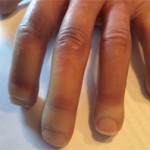“That’s true,” I answered.
“As a center for scleroderma, we take our time in these evaluations. There are scleroderma mimics: sclerodema, myxomatous granulomatosis, eosinophilia fasciitis, to name a few, and undoubtedly you’ve been reading about the eosinophilic myalgia syndrome,” he added, checking his watch. I hoped my face didn’t give away the fact that I had no idea what he was talking about. “Be thorough,” he added. “This is a multi-system disease. The skin changes can be heartbreaking, but the deeper involvement of the lungs, heart, bowels and kidneys, means they are where the most serious pathology may occur.”
My Patient No. 1: The History & Initial Exam
I pulled my first patient’s chart from the rack: 35 years old, female, married, two children, from—I flipped back to the information page—Albuquerque, N.M. Geophysicist. That’s interesting. There was a letter from her internist, a recent consult from the University of Arizona Arthritis Center, and reams of lab and radiographic studies. I scribbled down notes, intent on summarizing her case for my presentation to Dr. Medsger. Then I knocked lightly on the door and entered.
The woman I had waved to was my first patient, Jennifer Indura. She smiled again and introduced her husband, Michael. Up close, the skin involvement was even more disturbing and dramatic, her face waxy and taut, the fingers contracted, the forearms thickened and woody.
Together, we reviewed her recent history: “The Raynaud’s happened for the first time last winter when I went out to scrape ice off the windshield and forgot my mittens,” she began. “The fingers looked dead, like all the blood was drained out. A few months later, even putting my hand into the freezer to take out a package of frozen vegetables triggered an attack.” She turned her hands over. “That’s when I began to get these.”
The tips of the pointer finger and ring finger of the right hand were blackened and cool. She flinched, and her eyes welled up as I gently tried to pull the dressings off. Reflexively, her husband leaned forward and put his hand over mine. “Here, let me help you.” He reached into her handbag and pulled out a pint of sterile water to soak the gauze and applied a dab of Lidocaine gel to the base of the finger to numb the area. “There,” he exhaled, “that should make it easier to undress.”
“So the Raynaud’s came first? Any other problems begin at that time?” I asked, waiting for the anesthetic to take effect.



